We are lucky enough to live in a world where there's virtually no shortage of nifty kitchen gadgets. While there are fancy, high-tech tools like smart ovens and sous vide machines; sometimes the most useful kitchen tools are the ones that have been around forever, like the good old potato peeler. Originally called the Rex Potato Peeler, this useful utensil has been around since 1947 and is now a common household item that you'll find in a variety of shapes and sizes. Although it was originally invented for peeling the skins of potatoes, it is now commonly referred to as a vegetable peeler due to its versatility.
You may have used a vegetable peeler on potatoes or carrots, but did you know that this tool can also be used to peel an array of fruits, cheeses, and even soaps? Your cheapest kitchen gadget just became more valuable. Read further for some innovative ways to use a vegetable peeler.
1. Peel vegetable skins
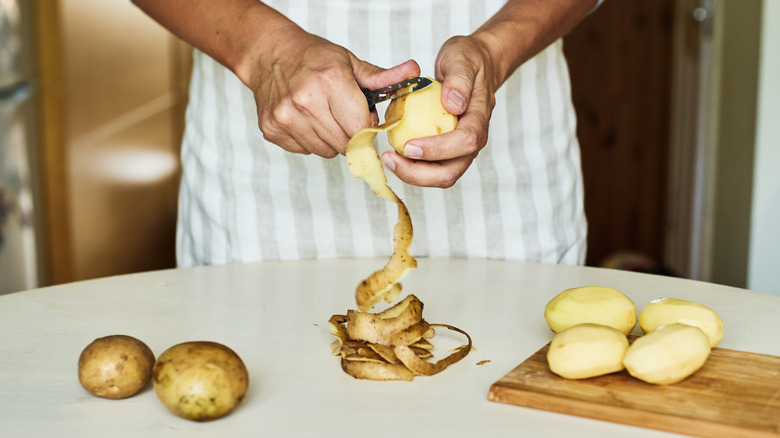
While there are numerous uses for a vegetable peeler, including creative uses you may not have considered, let's first discuss the primary reason you purchased a vegetable peeler in the first place: to peel vegetables.
The most common use for a vegetable peeler is probably peeling potato skins, which is why a vegetable peeler is often referred to as a potato peeler. In fact, many vegetable peelers even come with a pointed end specifically made for digging out those pesky spots where the potato skin won't come off, called "eyes." To peel a potato with a vegetable peeler, make sure you hold the vegetable with your non-dominant hand and peel with your dominant hand. Also, like your mother always said, make sure that you're peeling in a direction that is away from your body, not towards it (via Cranberry Island Kitchen). It's also common to use a vegetable peeler to peel whole carrots prior to cooking with them. Cook's Illustrated notes that though the carrot peels are edible, it's usually better to take the extra time to peel your carrots for better taste.
2. Make crispy potato chips
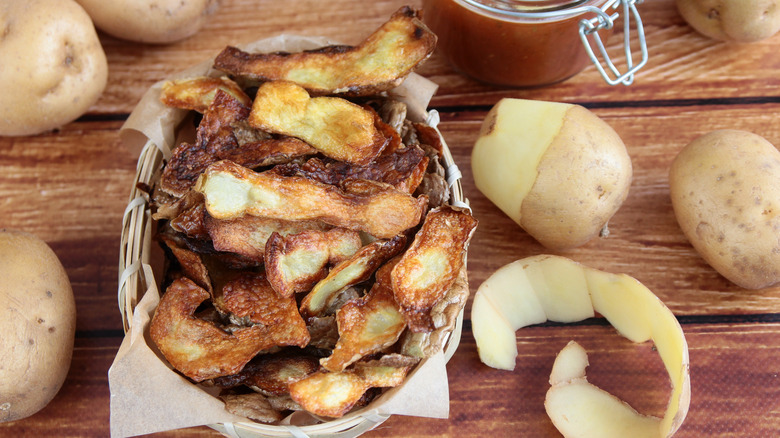
Potato skins are edible, but we usually peel them off to make dishes like mashed potatoes or potato salad. If you've peeled potatoes for these dishes before, you've probably tossed a decently large pile of unused potato skins into the trash. Whether you're conscious of the food waste or you'd like to try a new recipe, make sure that you save those yummy potato skins because we've got a good recipe for you.
While you can't make traditional potato chips without actual potatoes, you can still make crispy, delicious chips from potato skins! To make crunchy potato skin chips, the Framed Cooks suggests tossing the peels in olive oil, sprinkling them with sea salt, and baking them in a single layer at 425 F for around 20 minutes. This recipe is super simple and has the potential to be individualized however you'd like it, so feel free to add some of your favorite seasonings.
3. Easily slice onions
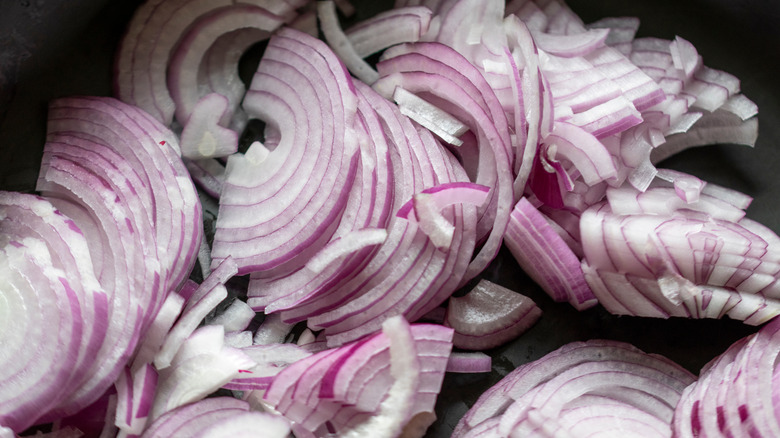
Do we cry while cutting onions because of their acids and enzymes, or because they're so frustrating to cut properly? In reality, it's a little bit of both. While dicing or slicing onions isn't necessarily rocket science, getting the pieces small enough or uniform in size can be challenging, especially if you aren't an expert in using knives.
However, you don't have to be a skilled knife-wielder to get nice, thin, crisp onion slices. After using a knife to cut your onion into quarters and remove the root ends, take your vegetable peeler and drag it along the edge of the onion (via Cutco). This should leave you with uniformly-sized ultra-thin slices. This method is ideal for recipes wherein chunky, or diced onions will be too large. Use these thin slices for foods like pizza or salads, where a bite of onion will be subtle rather than overpowering.
4. Peel tough fruit skins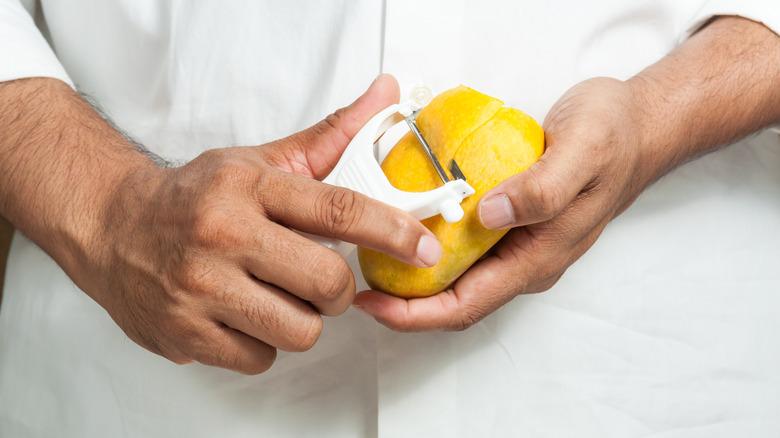
Anyone who's ever bought a mango from the store and went home to eat it knows that the worst part about mangos is peeling. They're not exactly an easy fruit to hold, especially since the skin often slips out of your hands when you try to remove it. This is where the vegetable peeler comes in. According to MasterClass, hold the mango firmly with one hand and press the blade of a vegetable peeler to the mango's skin firmly, maneuvering it a bit to break the skin if necessary. Then, simply peel the mango skin like you would a potato's skin — it's that easy!
Mango isn't the only awkward fruit to peel. A vegetable peeler is a perfect way to easily remove fruit skin efficiently without inadvertently taking large chunks out of the fruit or risking cutting your hand on a blade. You can use a vegetable peeler to peel small fruits with tough skins like kiwis or apples; just make sure that it's nice and sharp.
5. Make fancy salads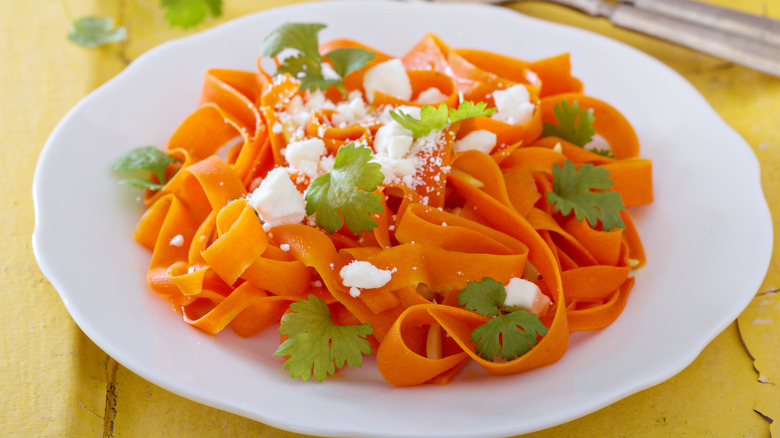
In today's world, there is no shortage of innovative tools that help us slice, dice, peel, and chop any vegetable into virtually any shape we need or want. Thanks to this, people have become very creative in the kitchen, making new recipes as we find that cutting vegetables into different shapes and sizes actually affects the way they taste and function in dishes.
You don't need to purchase any fancy kitchen gadgets for refined, elevated meals. Grab your trusty ol' vegetable peeler, some ripe veggies from your garden, and get ready to create some impressive healthy meals. When you use a vegetable peeler to shave lengthier vegetables like carrots, zucchini, squash, or cucumber, you wind up with lovely long, thin ribbons that are slightly crunchy and just fun to eat. For example, Tasty shares a summer salad recipe that calls for fresh homemade pesto drizzled atop zucchini, squash, and carrot ribbons.
6. Try zucchini noodles

You may recognize zucchini noodles — commonly referred to as "zoodles" — due to their recent popularity over the last few years. They became a popular low-carb or gluten-free alternative to flour-based pasta noodles, but they are also an easy, unique, and delicious way to include more vegetables in your diet.
It's common to use a spiralizer to make zucchini noodles that more closely resemble long, cylindrical strands of spaghetti. If you don't have a spiralizer, you can easily make a zucchini-based pasta dish with a vegetable peeler. By shaving flat ribbons of zucchini with a peeler, you're creating a zucchini pasta that more closely resembles fettuccini or pappardelle. The New York Times' recipe for zucchini pasta suggests peeling lengthwise ribbons from the vegetable, discarding the seeded core, and cooking the noodles for a few minutes in a saucepan with extra virgin olive oil, kosher salt, and tomato sauce.
7. Make drink garnishes

When you think of a bartender's toolkit, you probably envision a drink shaker, a muddler, and a bar spoon. Bartenders or their mixologist peers might also consider a vegetable peeler as one of their necessary tools. If you've never had an Old Fashioned or a lemon drop martini, you may not realize that it's common for some cocktails to include a fruit peel. If you know what we're talking about, you may have seen your bartender give the fruit peel a good twist above your drink or briefly light a flame to the peel before dropping it into your drink.
A citrus fruit's peel contains a number of aromatic oils that add extra flavor to a drink that the rest of the fruit wouldn't be able to. With a vegetable peeler, bartenders extract a section of the fruit's rind at a precise thickness to enhance certain beverages — they even select their peelers carefully, depending upon the type of fruit they're peeling (via Wine Enthusiast). Citrus fruits like lemons, oranges, limes, and grapefruits are among the commonly used fruits for these purposes. Aside from the added boost of flavor, a twisted orange or lemon peel also works as an elegant garnish for any beverage.
8. Remove strawberry stems
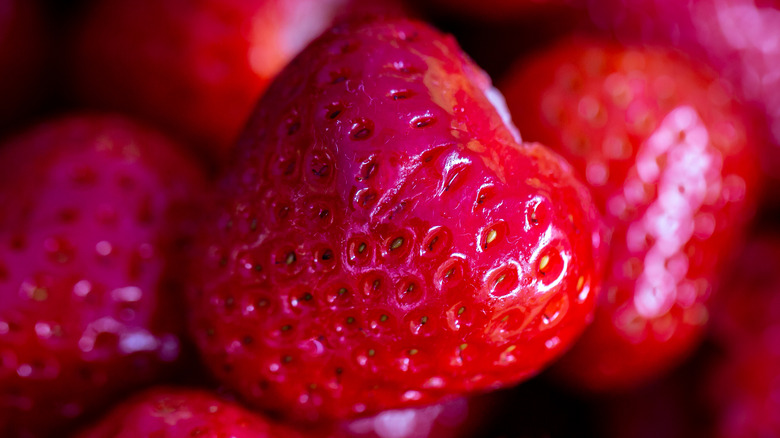
We all know that the most inconvenient part of the strawberry is its stem. By default, most people tend to simply slice off the top of the strawberry and its stem with a knife. While this method solves the stem-removal issue, it can often cause an inadvertent removal of a decent amount of the edible strawberry flesh. Moreover, slicing the top of the strawberry off takes away from the shape of the berry, making it less visually appealing.
We've got a totally unique, nifty method for efficiently removing strawberry stems without compromising the strawberry's aesthetic appeal. According to Fine Cooking, you can use the pointed end of the vegetable peeler to remove those pesky stems completely. The pointed end of the peeler is typically used for removing unwanted spots out of potatoes, but if you gently dig the tip underneath the strawberry stem and twist, it should pop right out!
9. De-string celery
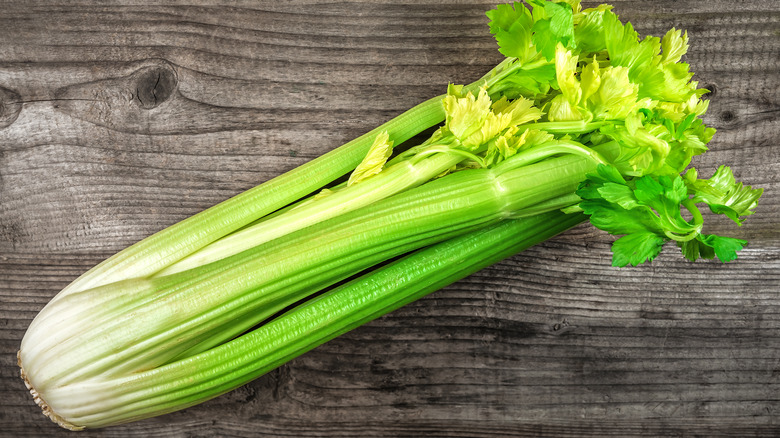
Notoriously low-calorie, celery is a very common snack for those looking to lose weight or those who simply want to be more health-conscious. According to Healthline, celery naturally contains tons of antioxidants, anti-inflammatory components, vitamins, and minerals beneficial to overall health.
Whether you've tried eating celery whole or chopping it up for recipes, you've probably run into that annoying, difficult-to-manage stringy part of the plant. According to Thrive Cuisine, those pesky stringy pieces can come about due to a celery stalk having grown in less-than-perfect conditions. They are simply part of the plant, and while they are completely edible, they can take away from the satisfying crunch of a bite of celery. Pick up a vegetable peeler and kiss your celery string fears goodbye. Thrive Cuisine reports that simply using the peeler to peel off the outer layer of a celery stalk removes the stringy threads, leaving you with a crisp stick of celery.
10. Make cheese shavings
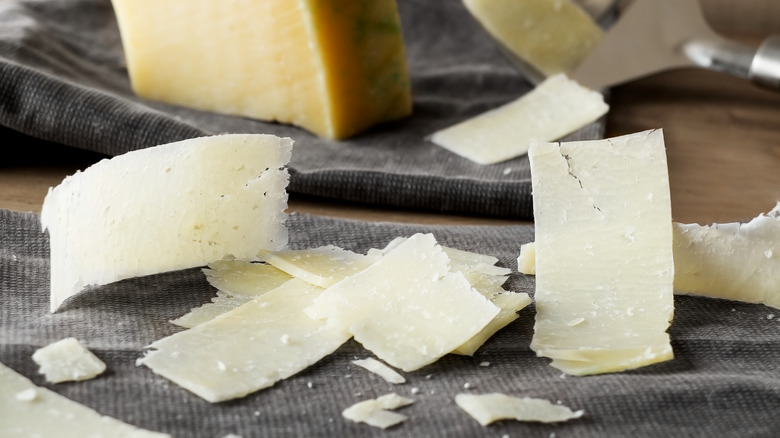
There will never be too many ways to enjoy cheese. Crumbled over salads, melted atop soups, sprinkled over pasta — if there's a chance to incorporate cheese into a dish, we'll find a way to do it, and we'll love it every time. One fantastic way to enjoy some cheeses that are typically hard and not very crumbly is to create cheese shavings to include in a dish.
While hard and aged cheeses like pecorino or Manchego are usually grated into small, more delicate pieces with a cheese grater, it's worth trying a vegetable peeler to obtain long, thin strips instead. These ultra-thin cheese peels complement dishes nicely, and they melt pretty quickly. Fine Cooking also notes that you can taste more of the cheese's flavor when it's in a peel form rather than grated. The next time you're tossing together a salad, try shaving some fresh parmesan rather than using a grater, and we bet you'll really love the difference.
11. Make chocolate shavings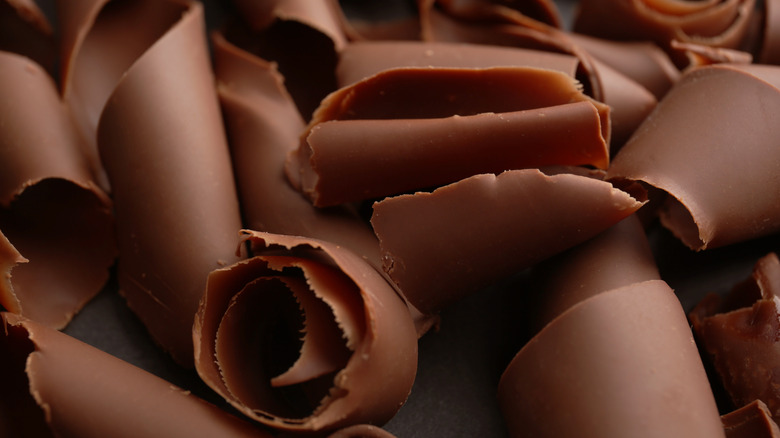
It doesn't matter the size, shape, or state of matter: We love chocolate. When it comes to desserts, we are always seeking out new recipes and creative ways to include chocolate. Using a vegetable peeler to make chocolate shavings or curls is a unique way to create artful, elegant desserts.
Food blog Culinary Hill notes that you can make chocolate shavings or chocolate curls out of various types of chocolate, whether you prefer milk chocolate, dark chocolate, or white chocolate. All you have to do is drag the vegetable peeler blade along a bar of chocolate, experimenting with different shapes and sizes by peeling different sides of the chocolate bar. Remember to do this when the chocolate is at room temperature, so it isn't too hard or overly soft. Chocolate shavings can take any dessert to a more refined level. Shave them on top of a decadent chocolate pavlova, or use them to decorate your favorite chocolate cake.
12. Make shaved butter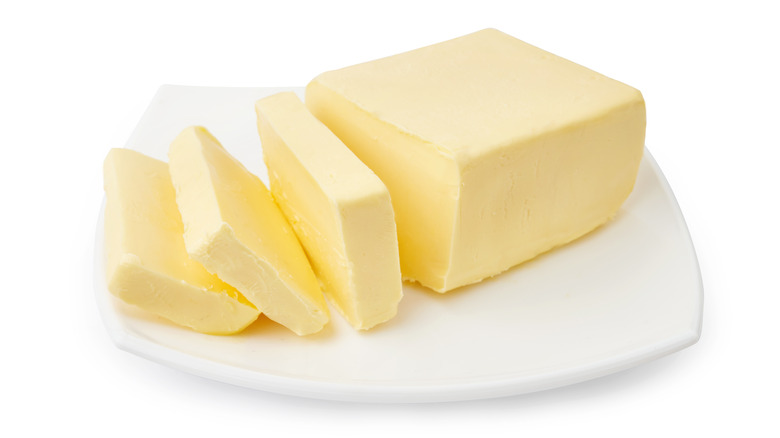
We've all been there. You're in the mood to bake some quick cookies, or you're craving a good slice of buttered toast, but you take a stick of butter out of the fridge, and it's rock-solid. A common solution for this dilemma is to toss the stick of butter into the microwave for a few seconds, but sometimes this can cause you to melt the butter too much, risking your recipe or the whole stick of butter. Or, maybe you stored a stick of butter in the freezer for a pastry recipe and are struggling to cut into it.
No matter the situation, a too-hard stick of butter can be conquered with one simple tool: the vegetable peeler. Rather than trying to smush a hard chunk of butter into your bread, tearing the bread, and unevenly spreading the butter, approach the butter another way. Hold your stick of butter and gently peel a few thin curls of butter onto your toast, and watch it melt quickly and evenly .
13. Carve decorative soaps

Yes, you can use a vegetable peeler for something outside the kitchen! Although we call it a vegetable or potato peeler, these tools are really just sharpened blades that are easy to hold and maneuver. As such, you can technically use them to carve many things or even to sharpen pencils.
A vegetable peeler is a popular tool for those who create craft soaps, as it helps to bevel the bars of soap to have smooth, clean-looking edges. This helps the artful soaps look more professional and appealing. When beveling, try to ensure that you are using a steady amount of pressure while peeling to avoid uneven peels. Those in the field of soap art also use vegetable peelers to carve designs into bars of soap. Can a vegetable peeler make you famous? Maybe, if you decide to set up a camera, grab your bar of soap and your vegetable peeler and film one of those viral soap peeling
No comments:
Post a Comment